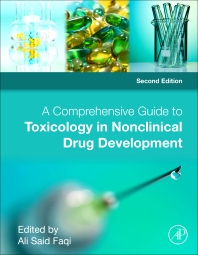Books in Toxicology testing and evaluation
Books in Toxicology testing and evaluation
- 3rd Edition
- February 11, 2024
- Ali S. Faqi
- English
- Hardback9 7 8 0 3 2 3 8 5 7 0 4 8
- eBook9 7 8 0 3 2 3 9 8 4 6 2 1

A Comprehensive Guide to Toxicology in Nonclinical Drug Development
- 1st Edition
- October 20, 2018
- Michael Balls + 2 more
- English
- Paperback9 7 8 0 1 2 8 1 3 6 9 7 3
- eBook9 7 8 0 1 2 8 1 3 6 9 8 0

The History of Alternative Test Methods in Toxicology
- 1st Edition
- September 26, 2017
- Ashutosh Kumar + 3 more
- English
- Paperback9 7 8 0 1 2 8 0 9 2 5 2 1
- eBook9 7 8 0 1 2 8 0 9 2 6 0 6

Mutagenicity: Assays and Applications
- 2nd Edition
- November 3, 2016
- Ali S. Faqi
- English
- Hardback9 7 8 0 1 2 8 0 3 6 2 0 4
- eBook9 7 8 0 1 2 8 0 3 6 2 1 1

A Comprehensive Guide to Toxicology in Nonclinical Drug Development
- 1st Edition
- May 26, 2016
- Ray Proudlock
- English
- Paperback9 7 8 0 1 2 8 0 0 7 6 4 8
- eBook9 7 8 0 1 2 8 0 1 0 0 6 8

Genetic Toxicology Testing
- 1st Edition
- January 25, 2014
- Ramesh C. Gupta
- English
- eBook9 7 8 0 1 2 4 0 4 6 4 9 8

Biomarkers in Toxicology
- 1st Edition
- October 22, 2013
- Wayland J. Hayes
- English
- eBook9 7 8 1 4 8 3 2 6 2 8 3 3

Essays in Toxicology
- 1st Edition
- October 22, 2013
- Wanda M Haschek + 1 more
- English
- eBook9 7 8 1 4 8 3 2 8 8 6 1 1

Handbook of Toxicologic Pathology
- 4th Edition
- October 7, 2011
- Peter Greaves
- English
- Hardback9 7 8 0 4 4 4 5 3 8 5 6 7

Histopathology of Preclinical Toxicity Studies
- 3rd Edition
- February 23, 2007
- Peter Greaves
- English
- eBook9 7 8 0 0 8 0 4 7 1 3 0 3
